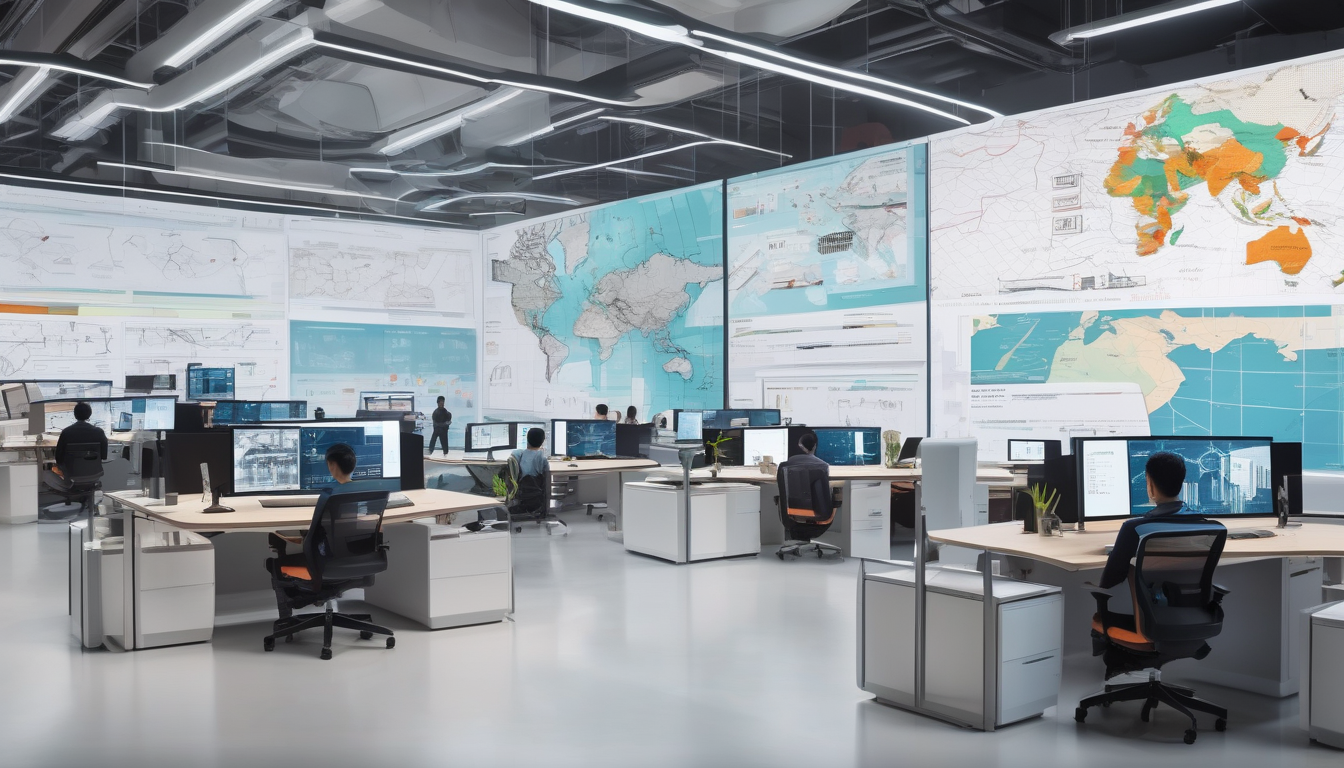The landscape of artificial intelligence (AI) is undergoing a monumental shift, and at the forefront of this transformation is China. As the nation accelerates its AI capabilities, the implications for global competition are profound. Have you ever wondered how a single country’s technological advancements can ripple across the globe? Well, China’s AI journey is doing just that, reshaping industries, redefining innovation, and altering geopolitical dynamics.
China’s AI advancements are not just a story of technological prowess; they represent a strategic vision backed by substantial government support and investment. The Chinese government has recognized the potential of AI as a driving force for economic growth and global leadership. With a clear roadmap laid out in initiatives like the New Generation Artificial Intelligence Development Plan, the country is positioning itself to dominate the AI landscape.
This rapid development is fueled by a mix of factors, including massive funding for research and development, aggressive talent acquisition, and a robust network of public-private partnerships. For instance, companies like Baidu, Alibaba, and Tencent are not just players but key architects of this AI revolution. Their collaboration with the government creates a fertile ground for innovation, pushing boundaries in areas such as machine learning and natural language processing.
But what does this mean for the rest of the world? As China continues to make strides in AI, countries like the United States and those in Europe face a dual challenge: to innovate while also navigating the competitive pressures that arise from China’s advancements. The stakes are high, as maintaining technological leadership is crucial for economic security and geopolitical influence.
However, it’s not all about competition. Amidst the rivalry, there exist opportunities for collaboration that could lead to shared advancements in AI. Engaging in partnerships could foster innovation that benefits not just one nation but the entire global community. So, as we look towards the future, the question remains: will nations choose to compete fiercely, or will they find common ground to collaborate in the AI arena?

Overview of China’s AI Landscape
China’s artificial intelligence (AI) landscape is a vibrant tapestry woven with innovation, ambition, and strategic foresight. Over the past decade, the nation has transformed itself into a global powerhouse in AI technology, driven by a combination of government initiatives, substantial investments, and a growing pool of talent. This evolution has not only reshaped the tech industry within China but has also sent ripples across the globe, challenging the traditional dominance of Western nations.
At the heart of this transformation is a robust ecosystem comprising major players like Baidu, Alibaba, and Tencent, each contributing unique strengths to the AI domain. These tech giants are not just competing in the marketplace; they’re also collaborating with universities and research institutions to push the boundaries of what’s possible. For instance, Baidu’s advancements in natural language processing and Alibaba’s innovations in computer vision illustrate the diverse applications of AI technologies in various sectors, from e-commerce to healthcare.
Moreover, the Chinese government has set ambitious goals for AI development, aiming to become the world’s leader by 2030. This vision is supported by policies that encourage research and development, along with significant financial backing. The government’s New Generation Artificial Intelligence Development Plan outlines strategies to enhance AI capabilities, focusing on areas such as machine learning, robotics, and big data analytics. These initiatives are crucial as they provide the necessary framework for fostering innovation and attracting both domestic and international investments.
As we delve deeper into this dynamic landscape, it becomes clear that China’s AI advancements are not merely a national endeavor. They signify a shift in the global tech balance, prompting other nations to reassess their strategies in the face of this rapid evolution. The interplay between government support, corporate innovation, and international collaboration paints a picture of a nation poised to redefine the future of technology.

Government Policies Driving AI Innovation
The Chinese government has become a powerhouse in driving AI innovation through a series of strategic policies and initiatives. These efforts are not just about funding; they encompass a comprehensive approach that integrates research, development, and practical implementation. With a clear vision laid out in the Next Generation Artificial Intelligence Development Plan, the government aims to transform China into a global leader in AI by 2030.
One of the most significant aspects of these policies is the substantial investment in AI research and development. The government allocates billions of dollars annually to support various AI projects, ranging from healthcare solutions to autonomous vehicles. For instance, in recent years, funding has surged for initiatives focusing on machine learning and natural language processing, which are pivotal for enhancing AI capabilities. This financial backing creates an environment where innovation can thrive, attracting both domestic and international talent.
Moreover, the Chinese government fosters collaboration between public institutions and private enterprises, recognizing that public-private partnerships are essential for accelerating AI development. Companies like Baidu, Alibaba, and Tencent have formed alliances with universities and research institutions, pooling resources and expertise to push the boundaries of AI technology. These collaborations have proven fruitful, leading to breakthroughs that not only benefit China but also contribute to global advancements in AI.
Additionally, China’s international collaborations play a crucial role in enhancing its AI landscape. By engaging with global partners, China gains access to cutting-edge technologies and expertise. This knowledge transfer is a two-way street, fostering innovation on a global scale. Countries such as the United States and European nations have been both competitors and collaborators, highlighting the complex dynamics of international relations in the tech space.
In conclusion, the government’s proactive policies are not merely about keeping pace with global trends; they are about setting the pace. As China continues to invest in AI innovation, the implications for global competition and collaboration will be profound, shaping the future of technology worldwide.
Investment in AI Research and Development
In the race for artificial intelligence supremacy, China’s commitment to investment in AI research and development is nothing short of remarkable. With billions of dollars pouring into this sector, the nation is laying the groundwork for a future where AI technologies are not just advanced but integrated into every facet of life. These investments come from both the government and private sectors, creating a robust ecosystem that nurtures innovation.
One of the standout features of China’s approach is the establishment of innovation hubs that serve as hotbeds for AI research. Cities like Beijing and Shenzhen are becoming synonymous with technological breakthroughs, attracting talent and fostering collaboration. For instance, the Chinese government has allocated over $20 billion to support AI initiatives, which has sparked a wave of startups and research projects aimed at pushing the boundaries of what AI can achieve.
Moreover, partnerships between public institutions and private companies are pivotal. These collaborations not only enhance research capabilities but also facilitate the commercialization of AI technologies. Companies like Baidu, Alibaba, and Tencent are at the forefront, working hand-in-hand with universities and research institutes to develop cutting-edge applications ranging from autonomous vehicles to smart healthcare solutions.
To illustrate the scale of investment, consider the following table that outlines some key funding initiatives:
| Initiative | Amount (in billions) | Focus Area |
|---|---|---|
| National AI Development Plan | 15 | Research and Innovation |
| AI Innovation Fund | 5 | Startup Support |
| University Research Grants | 2 | Academic Research |
In conclusion, the scale and focus of investment in AI research and development in China are reshaping the global landscape. With such a strong foundation, the country is not just participating in the AI race; it is setting the pace. As these investments continue to bear fruit, the implications for global competition and innovation will be profound.
Public-Private Partnerships in AI
The landscape of artificial intelligence in China is not just shaped by government initiatives but is also significantly influenced by public-private partnerships. These collaborations are akin to a dynamic dance, where both sectors bring their strengths to the table, creating a synergy that accelerates innovation. By pooling resources, knowledge, and expertise, these partnerships are driving AI advancements at an unprecedented pace.
One of the standout examples of this collaboration is the partnership between tech giants and state-owned enterprises. Companies like Baidu and Alibaba are not just competing; they are also working hand in hand with government agencies to develop cutting-edge AI technologies. This collaboration often results in the rapid commercialization of AI applications, which can be seen in various sectors, including healthcare, transportation, and finance.
Moreover, these partnerships are fueled by significant funding initiatives. The Chinese government has allocated billions to support AI research projects, which often involve collaborations with private companies. This investment is not merely a financial boost; it also fosters an environment where startups can thrive. For instance, small tech firms benefit from access to government resources and expertise, allowing them to innovate more effectively.
Additionally, public-private partnerships are instrumental in creating AI research hubs across the country. These hubs serve as incubators for new ideas and technologies, where researchers from universities, private companies, and government entities come together. This collaborative environment not only enhances knowledge sharing but also accelerates the development of practical AI solutions that can be deployed in real-world scenarios.
In summary, the power of public-private partnerships in China’s AI sector cannot be overstated. By leveraging the strengths of both the public and private sectors, China is not only enhancing its AI capabilities but is also setting a precedent for how nations can collaborate to drive technological innovation. As the global AI race heats up, these partnerships will likely play a crucial role in shaping the future of technology.
International Collaborations and Knowledge Transfer
The landscape of artificial intelligence (AI) is not just a national affair; it’s a global symphony where countries like China are playing a leading role. International collaborations are becoming increasingly vital for enhancing AI capabilities. By forming strategic partnerships with leading tech companies and research institutions around the world, China is not only boosting its own AI expertise but also fostering a culture of knowledge transfer that benefits all parties involved.
For instance, collaborations with tech giants from the United States and Europe have led to significant advancements in various AI fields, including machine learning, natural language processing, and computer vision. These partnerships often involve joint research initiatives, sharing of resources, and even cross-border talent exchanges. Such interactions allow for a rich exchange of ideas and methodologies that can accelerate innovation.
One notable example is the partnership between Chinese universities and international research institutions. These collaborations often result in groundbreaking research papers and technological advancements that push the boundaries of what AI can achieve. The table below highlights some key international collaborations and their impact:
| Collaboration Partner | Area of Focus | Impact |
|---|---|---|
| MIT | Machine Learning | Development of advanced algorithms |
| Oxford University | Natural Language Processing | Improved language models |
| Stanford University | Computer Vision | Innovative image recognition systems |
Moreover, the Chinese government actively encourages these international ties by providing funding and resources to facilitate collaborative projects. This proactive approach not only accelerates China’s AI development but also positions it as a key player in the global tech arena. As the world becomes more interconnected, the importance of these collaborations will only continue to grow, making knowledge transfer a cornerstone of future AI advancements.
Key Technologies Shaping AI in China
China is experiencing a technological renaissance, and at the heart of this transformation are key AI technologies that are reshaping industries and redefining the future. One of the most prominent technologies is machine learning, which enables systems to learn from data and improve over time without explicit programming. This capability is not just a theoretical concept; it’s being applied in real-world scenarios, from enhancing e-commerce recommendations to optimizing supply chain logistics.
Another significant player in this landscape is natural language processing (NLP). With the rise of digital communication, the ability to understand and generate human language has become crucial. Chinese tech giants are investing heavily in NLP to develop chatbots, translation services, and voice recognition systems that can converse in Mandarin as naturally as a human. Imagine having a conversation with your device that feels as fluid as chatting with a friend!
Additionally, computer vision is making waves in various sectors, including security and retail. By enabling machines to interpret and understand visual information from the world, computer vision technologies are being used in facial recognition systems, autonomous vehicles, and even smart cities. For example, cities in China are deploying these technologies to enhance public safety and improve traffic management.
To illustrate the breadth of these technologies, here’s a table summarizing their applications:
| Technology | Applications |
|---|---|
| Machine Learning | E-commerce recommendations, predictive analytics, fraud detection |
| Natural Language Processing | Chatbots, translation services, sentiment analysis |
| Computer Vision | Facial recognition, autonomous vehicles, smart city surveillance |
In summary, the key technologies shaping AI in China are not just buzzwords; they are powerful tools that are driving innovation and opening up new avenues for economic growth. As these technologies continue to evolve, they will undoubtedly play a pivotal role in establishing China’s position as a global leader in AI.

Impacts on Global Competition
The rapid advancements in China’s artificial intelligence (AI) landscape are sending shockwaves through global competition. As China’s AI capabilities grow, they are reshaping the dynamics of international markets and influencing trade relationships. With a focus on innovation, China is not just catching up; it is positioning itself as a formidable leader in various sectors, from healthcare to transportation.
One of the most significant impacts of China’s AI surge is the shift in technological leadership. Countries that once dominated the tech scene are now facing increased pressure to innovate and adapt. The competition is fierce, and nations like the United States and those in Europe must rethink their strategies to maintain their edge. How can they respond effectively? Here are some challenges they face:
- Increased Investment: Western nations need to ramp up their investments in AI research and development to keep pace with China’s aggressive funding.
- Talent Acquisition: Attracting top talent in AI is crucial. Countries must create environments that foster innovation and retain skilled professionals.
- Regulatory Frameworks: Developing policies that encourage growth while ensuring ethical standards is essential for sustainable progress.
Despite these challenges, the rise of China’s AI capabilities also opens doors for collaboration. Countries can explore partnerships that leverage each other’s strengths, fostering a more interconnected global AI ecosystem. For instance, joint research initiatives or technology exchanges can lead to breakthroughs that benefit all parties involved.
In conclusion, as China’s AI advancements continue to evolve, they are not only transforming its own economy but also reshaping the global competitive landscape. The question remains: will Western nations rise to the challenge, or will they be left in the dust? The future of global competition hinges on the ability to adapt, innovate, and collaborate in this rapidly changing environment.
Challenges for Western Nations
The rapid rise of China’s AI capabilities poses significant challenges for Western nations, reshaping the landscape of global competition. As China continues to invest heavily in artificial intelligence, Western countries find themselves grappling with the need to innovate and adapt quickly. The technological race is not just about who can develop the most advanced AI systems; it’s also about maintaining economic stability and national security.
One of the primary challenges lies in the competitive pressure that China’s advancements create. Western companies are now facing increased competition in various sectors, from healthcare to finance, where AI is playing a transformative role. For instance, Chinese firms are making strides in areas like predictive analytics and automated decision-making, which could disrupt traditional business models in the West.
Moreover, the strategic responses required to counteract these developments are complex. Western nations must not only ramp up their investment in AI research but also enhance their education systems to cultivate a workforce skilled in these emerging technologies. This could involve:
- Increasing funding for STEM education
- Fostering innovation through grants and subsidies
- Encouraging collaboration between academia and industry
Additionally, there is a pressing need for robust regulatory frameworks that can keep pace with the rapid advancements in AI. Western nations must navigate the delicate balance between fostering innovation and ensuring ethical standards in AI development. This includes addressing concerns related to privacy, data security, and algorithmic bias.
In summary, the challenges posed by China’s AI advancements require a multifaceted approach from Western nations. It’s not just about competition; it’s about collaboration, innovation, and the need to create a sustainable framework that can thrive in this new technological era.
Opportunities for Collaboration
In the ever-evolving landscape of artificial intelligence, the notion of collaboration between nations is not just a buzzword; it’s a necessity. As China accelerates its AI capabilities, the potential for partnerships with other countries opens up a world of opportunities. Imagine a scenario where countries come together, pooling their resources and expertise to tackle global challenges. This collaboration could lead to groundbreaking innovations that benefit everyone involved.
One of the most compelling aspects of collaboration is the sharing of knowledge and technology. For instance, Chinese firms have made significant strides in areas like machine learning and natural language processing. By partnering with Western companies, there’s an opportunity to blend these advancements with established methodologies and frameworks. This fusion could result in solutions that are not only innovative but also more effective in addressing complex issues.
Moreover, international collaborations can enhance the pace of research and development. When countries work together, they can leverage each other’s strengths. For example:
- Resource Sharing: Countries can share data sets and computing resources, which are crucial for training AI models.
- Joint Research Initiatives: Collaborative projects can lead to shared breakthroughs in AI technology.
- Cross-Border Talent Exchange: Encouraging talent exchange programs can foster a diverse pool of ideas and innovations.
However, it’s essential to navigate the challenges that come with these collaborations. Trust and transparency will be key factors in ensuring that partnerships are beneficial for all parties involved. By establishing clear communication and mutual goals, nations can create a framework that not only promotes innovation but also addresses ethical concerns surrounding AI.
In conclusion, the opportunities for collaboration in AI are vast and varied. By embracing these partnerships, countries can not only enhance their technological capabilities but also contribute to a more interconnected and innovative global landscape. The future of AI is not solely in competition; it’s also in collaboration.
Frequently Asked Questions
- What are the key factors driving China’s AI advancements?
China’s AI advancements are fueled by extensive government support, significant investments in research and development, and a robust ecosystem of private enterprises. The government’s strategic policies and funding initiatives create an environment ripe for innovation.
- How does China’s AI landscape compare to that of Western nations?
While Western nations have a strong foundation in AI research, China’s rapid growth and aggressive investment strategies pose a unique challenge. China’s focus on collaboration between public and private sectors allows for faster implementation of AI technologies, potentially outpacing its Western counterparts.
- What role do public-private partnerships play in China’s AI growth?
Public-private partnerships are crucial as they combine resources and expertise from both sectors, driving innovation and commercialization of AI technologies. These collaborations facilitate knowledge sharing and accelerate the development of cutting-edge solutions.
- Are there opportunities for international collaboration in AI?
Absolutely! Despite the competitive landscape, there are numerous opportunities for countries to collaborate with China in AI research. Such partnerships can lead to shared innovations and advancements that benefit the global community.
- What challenges do Western nations face due to China’s AI advancements?
Western nations must navigate competitive pressures and adapt their strategies to maintain technological leadership. This includes investing in AI research and fostering innovation to keep pace with China’s rapid developments.



